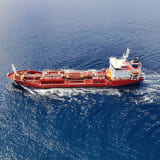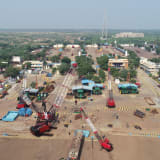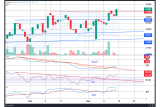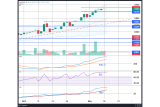
We are already on the eve of the summer, which is a traditionally slow period for most industries, chemicals included. The summer lull is a time dreaded by chemical tanker shipowners, as demand slows down and ship earnings slump, before staging a recovery from October onwards.
But it appears that this year it will be different. The reason? The extreme uncertainty in the US trade policy since Donald Trump’s inauguration in January.
Here’s a brief timeline of the tariff announcements since then:
January:
-
- 20 Jan – Trump announced plans to reshape the global trade system.
February:
-
- 1 Feb – 25% tariffs announced on imports from Mexico and Canada, as well as 10% additional tariff on imports from China
- 3 Feb – Mexico and Canada managed to arrange a 1-month pause before tariffs are applied
- 4 Feb – China announced limited retaliatory tariffs on imports from the US
- 10 Feb – Tariffs on all steel and aluminum imports in the US were increased to 25%, taking effect from 12 Mar.
- 12 Feb – Trump announced plans to impose 25% tariffs on automobile and auto parts imports, with implementation beginning 2 Apr.
March:
-
- 4 Mar – The 25% tariffs on imports from Mexico and Canada took effect. Additional 10% on Chinese imports announced.
- 26 Mar – New 25% tariffs on cars and car parts imported into the US announced, taking affect 2 Apr
April:
-
- 2 Apr – Dubbed “Liberation Day,” Trump declared a national emergency to address the trade deficit and announced a universal 10% tariff on all imports, effective April 5. Additionally, higher “reciprocal” tariffs were set for approximately 60 countries, effective April 9.
- 3 Apr – China announced new tariffs on farm products and machinery imports from the US
- 9 Apr – The US reciprocal tariff took effect, but meanwhile Trump announced 90-day pause during which trade deals with all affected countries should be struck. All countries except China got the 10% baseline tariff during that period, while tariffs on Chinese-origin imports were increased to 125%. The deminmis tariffs on postal packages from China were increased too.
- 10 Apr – China’s retaliatory tariff of 84% for imports from the US took effect
- 11 Apr – China matched the US levies of 125%, meanwhile the US exempted from the reciprocal tariffs the imports of smartphones, chips and electronics.
- 21 Apr – The US imposed tariffs as high as 3,000% on solar cells imports from SE Asia
- 25 Apr – China excluded imports of US ethane and polyethylene from its tariffs
- 29 Apr – The US offered offsets for US-made cars using imported parts
May:
-
- 8 May – The EU proposed tariffs on imports from the US, including chemicals and plastics. Meanwhile, the US and UK reached a partial deal whereby the US eliminated tariffs on UK steel, aluminum and aircraft parts and the tariffs on cars were cut from 27.5% to 10%.
- 12 May – The US and China announced a preliminary trade agreement, reducing tariffs by 115% for a 90-day period. Within this period, the tariff on Chinese goods is back to 30%, while the tariff on US goods is 10%.
- 16 May – Trump stated that the US would unilaterally set new tariff rates for various countries, citing the impracticality of negotiating individual trade deals with over 150 nations
If it looks messy – that’s because it is.
The chaotic signals coming out from the White House have made it increasingly challenging for companies to navigate the ever more complex and changing trade policy regime of the US. Besides the fact that the higher-than-expected tariffs on imports in the US are expected to result in a massive supply shock and a wave of price hikes from May onwards, the extreme uncertainty and volatility has put business and consumer decisions on just about everything on hold. Any reprieve from the tariffs chaos – even a temporary one – is perceived as an opportunity to hedge against more uncertainty in the future.
Impact on Markets and Chemical Tankers
As could be expected, business and consumers tried to beat the promised tariffs. In March US imports rose 5% to $342.7 billion, led by a record surge in consumer goods, while inbound shipments of motor vehicles and capital goods also increased. Exports increased by 1.2%.
In the chemical tanker market, the sentiment on the Transpacific trade lane was already souring in March after the US Trade Representative floated the plan to impose steep fees for each US port call on Chinese-built, -flagged or -owned vessels. Nevertheless, trade still continued albeit at a slower pace.
However, with the flurry of tariff hikes in April, trade between the US and China became all but impossible – contract volumes dropped, and spot demand evaporated overnight, making the Transpacific route eerily quiet. Freight rates held their ground though, as the threat of exorbitant port fees for Chinese-linked tonnage hanged in the air. It didn’t help that later in April the US came up with amended proposal for port fees, which practically exempted most of the chemical tanker fleet – the damage done by the extreme uncertainty was already there.
Thus, the announcement from 12 May about the reduction in tariffs between China and the US for 90 days was perceived as yet another twist and not the final outcome. With the 90-day period expiring on 14 Aug, once again companies are rushing to beat the deadline. As quickly as they had disappeared, export requirements from the US to China came back on the market. A surge in exports of finished goods can be expected from China to the US somewhere by early / mid-July.
So, this traditionally slow period may turn out to be rather busy and it is plausible the freight rates on the Transpacific trade lane will see a spike in this period. Of course, this is welcome news for shipowners. But once the trade frenzy is over, it may have well proven to be the pre-Christmas rush for this year – only this time 6 months earlier than usual. What this means is that the Transpacific chemical tanker market is poised for a likely slump from mid-/end July till the end of the year – even if there is further easing in the trade tensions between China and the US. Inventories built up during the June/July rush will take longer to clear on weaker global economic growth due to the trade tensions. Rampant chemical overcapacity amid weak demand and a wave of chemical tanker newbuildings coming out this year will further put downward pressure on the chemical tanker market. Freight rates will likely continue their decline through the second half of the year, dragging down with them also time charter rates and second-hand prices.
By Plamen Aleksandrov, Head of Research – Chemicals, SSY.
Articles
You may also be
interested in
View allGet in touch
Contact us today to find out how our expert team can support your business














